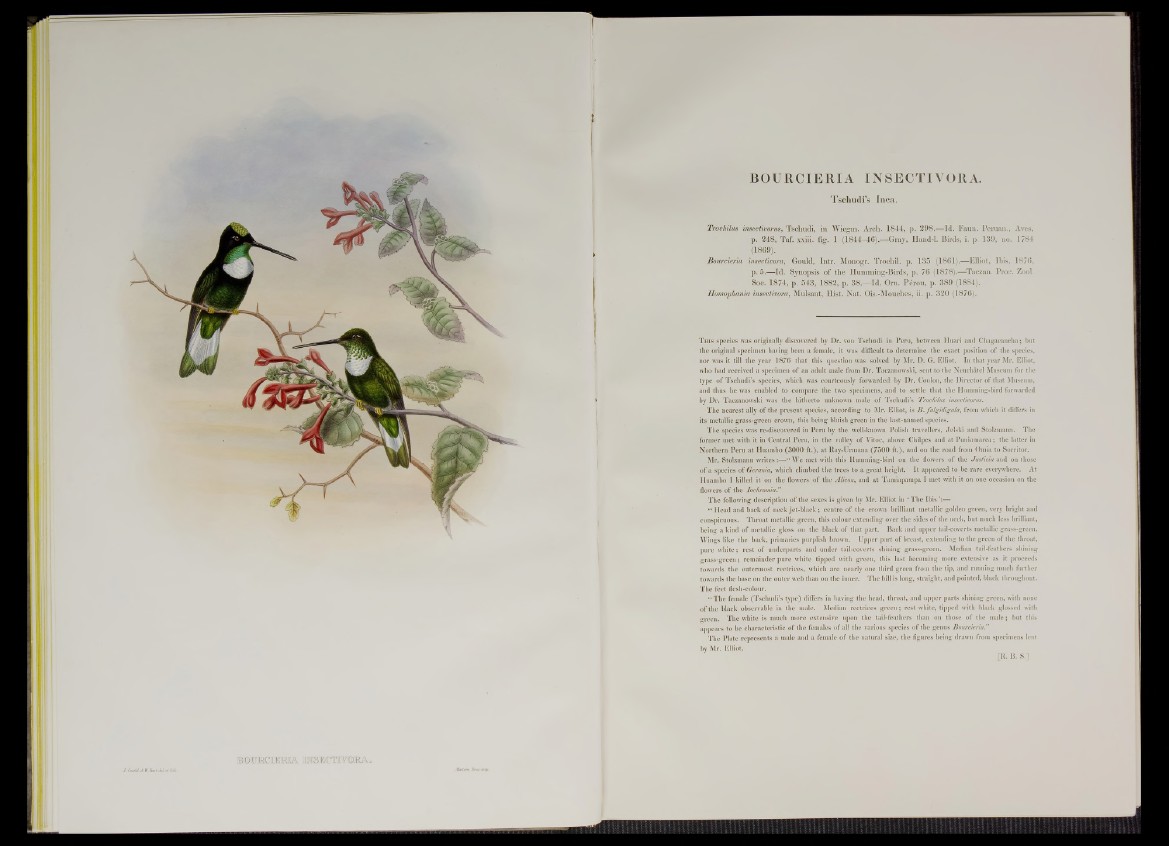
B O U IR O E M M . M S E C T H Y M A ,
BOURCIERIA INSECTIVORA.
Tschudi’s Inca.
Trochilus insectivorus, Tschudi, in W iegm . Arch. 1 8 4 4 , p. 2 9 8 .— Id. Faun. Peruan., Aves,
p. 2 4 8 , Taf. xxiii. fig. 1 (1 8 4 4 -4 6 ) .— Gray, Hand-1. Birds, i. p 1 39, no. 1784
(1869)'.
Bourcieria insectivora, Gould, Intr. Monogr. Trochil. p. 13 5 (1861).— Elliot, Ibis, 1 876,
p. 5.— Id. Synopsis o f th e Humming-Birds, p. 7 6 (1878).— Taczan. Proc. Zool.
Soc. 1 8 7 4 , p. 5 43, 1 8 8 2 , p. 3 8 .— Id. Orn. Pérou, p. 3 8 9 (1884).
Homophania insectivora, Mulsant, Hist. N a t. Ois.-Mouches, ii. p. 3 2 0 (1876).
T his species was originally discovered by Dr. von Tschudi in Peru, between Huari and Chagacancha; but
the original specimen haviug been a female, it was difficult to determine the exact position of the species,
nor was it till the year 1876 that this question was solved by Mr. D. G. Elliot. In that year Mr. Elliot,
who had received a specimen of an adult male from Dr. Taczanowski, sent to the Neuchatel Museum for the
type of Tschudi’s species, which was courteously forwarded by Dr. Coulon, the Director of that Museum,
and thus he was enabled to compare the two specimens, and to settle that the Humming-bird forwarded
by Dr. Taczanowski was the hitherto unknown male of Tschudi’s Trochilus insectivorus.
The nearest ally of the present species, according to Mr. Elliot, is B.fulgidigula, from which it differs in
its metallic grass-green crown, this being bluish green in the last-named species.
The species was re-discovered in Peru by the well-known Polish travellers, Jelski and Stolzmann. The
former met with it in Central Peru, in the valley o f Vitoc, above Chilpes and at Puniatnarca; the latter in
Northern Peru at Huambo (3000 ft.), at Ray-Urmana (7500 ft.), and on the road from Omia to Sorritor.
Mr. Stolzmann writes ; - 9 W e met with this Humming-bird on the flowers of the Justicia and on those
o f a species of Gerania, which climbed the trees to a great height. It appeared to be rare everywhere. At
Huambo I killed it on the flowers of the Alicon, and at Tamiapampa I met with it on one occasion on the
flowers of the Iochromia.”
The following description of the sexes is given by Mr. Elliot in ‘ The Ibis ’:—
“ Head and back of neck jet-black; centre o f the crown brilliant metallic golden green, very bright and
conspicuous. Throat metallic green, this colour extending over the sides o f the neck, but much less brilliant,
being a kind o f metallic gloss on the black of that part. Back and upper tail-coverts metallic grass-green.
Wings like the back, primaries purplish brown. Upper part of breast, extending to tbe green of tbe throat,
pure white; rest o f underparts and under tail-coverts shining grass-green. Median tail-feathers shining
grass-green; remainder pure white tipped with green, this last becoming more extensive as it proceeds
towards the outermost- rectrices, which are nearly one third green from the tip, and running much further
towards the base on the outer web than on the inner. The bill is long, straight, and pointed, black throughout.
The feet flesh-colour.
“ The female (Tschudi’s type) differs in having the head, throat, and upper parts shining green, with none
o f the black observable in tbe male. Median rectrices green; rest white, tipped with black glossed with
green. The white is much more extensive upon the tail-feathers than on those of the male; but this
appears to be characteristic of the females of all the various species o f the genus Bourcieria.”
The Plate represents a male and a female of the natural size, the figures being drawn from specimens lent
by Mr. Elliot.
[R. B. S.]